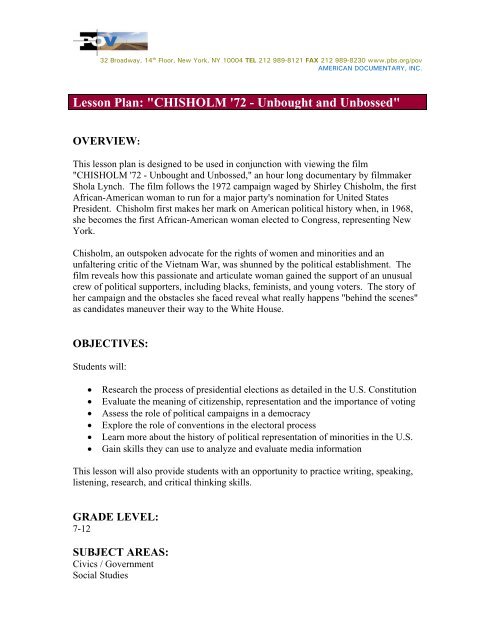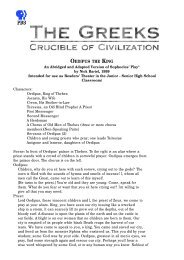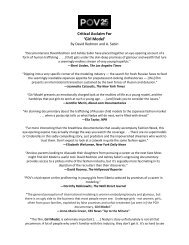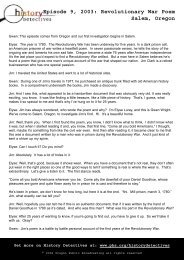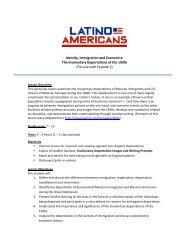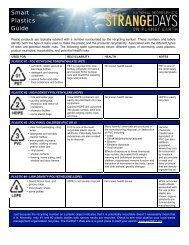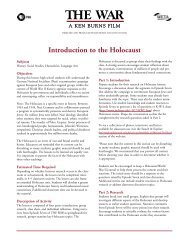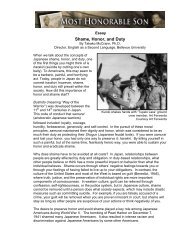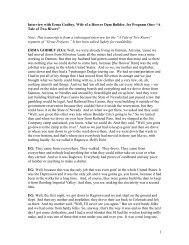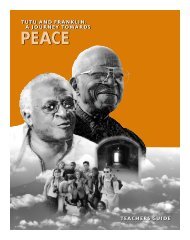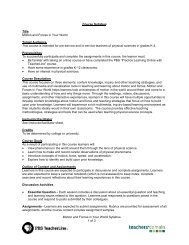Lesson Plan - PBS
Lesson Plan - PBS
Lesson Plan - PBS
- No tags were found...
Create successful ePaper yourself
Turn your PDF publications into a flip-book with our unique Google optimized e-Paper software.
32 Broadway, 14 th Floor, New York, NY 10004 TEL 212 989-8121 FAX 212 989-8230 www.pbs.org/povAMERICAN DOCUMENTARY, INC.<strong>Lesson</strong> <strong>Plan</strong>: "CHISHOLM '72 - Unbought and Unbossed"OVERVIEW:This lesson plan is designed to be used in conjunction with viewing the film"CHISHOLM '72 - Unbought and Unbossed," an hour long documentary by filmmakerShola Lynch. The film follows the 1972 campaign waged by Shirley Chisholm, the firstAfrican-American woman to run for a major party's nomination for United StatesPresident. Chisholm first makes her mark on American political history when, in 1968,she becomes the first African-American woman elected to Congress, representing NewYork.Chisholm, an outspoken advocate for the rights of women and minorities and anunfaltering critic of the Vietnam War, was shunned by the political establishment. Thefilm reveals how this passionate and articulate woman gained the support of an unusualcrew of political supporters, including blacks, feminists, and young voters. The story ofher campaign and the obstacles she faced reveal what really happens "behind the scenes"as candidates maneuver their way to the White House.OBJECTIVES:Students will:• Research the process of presidential elections as detailed in the U.S. Constitution• Evaluate the meaning of citizenship, representation and the importance of voting• Assess the role of political campaigns in a democracy• Explore the role of conventions in the electoral process• Learn more about the history of political representation of minorities in the U.S.• Gain skills they can use to analyze and evaluate media informationThis lesson will also provide students with an opportunity to practice writing, speaking,listening, research, and critical thinking skills.GRADE LEVEL:7-12SUBJECT AREAS:Civics / GovernmentSocial Studies
U.S. HistoryESTIMATED TIME NEEDED:3-5 class periods, plus homework preparationMATERIALS:• Videotape of "CHISHOLM '72 - Unbought and Unbossed" and equipment toshow it. P.O.V. documentaries can be taped off-the-air and used for educationalpurposes for up to one year from the initial broadcast.• Internet access for student research• Copies of the U.S. ConstitutionBACKGROUND:Many schoolchildren are asked, as part of a class assignment, to imagine…"If you werepresident of the United States, what would you do? What laws would you change?" Thepresident is the leader of our democracy, and the process of electing the president istaught as an example of our democracy at work. This process was set up in the UnitedStates Constitution, which requires a candidate for the presidency to meet threequalifications: to be at least 35 years old, a natural born citizen of the United States, anda resident of the United States for 14 years.When asked why she declared her candidacy for President of the United States in 1972,Shirley Chisholm explained, "I ran because somebody had to do it first. In this countryeverybody is supposed to be able to run for President, but that has never really been true."Her campaign, as seen in the film, provides a case study for students to see the "behindthe scenes" reality of waging a presidential campaign.As the first African-American woman to run for President, Chisholm also represented animportant opportunity for historically disenfranchised segments of the Americanpopulation to have a "voice" in the nation's political scene. Her candidacy receivedsupport from various factions of the civil rights movement and from the growingwomen's rights movement. The film reveals the political maneuvering infamous inAmerican politics, as Chisholm gains and loses supporters while forging the "Chisholmtrail" to the 1972 Democratic political convention in Miami, Florida.This lesson plan is designed to help students explore the realities of Americanpresidential politics, and understand reasons why the candidate a voter believes is "thebest candidate" may not be the one elected. The writing exercise and discussion will alsohelp students learn about the historical significance of Chisholm as a Black womanrunning for national office, and the challenges she faced in her candidacy.ACTIVITY:
ProcedureEstablish a framework for understanding the issues by reviewing the above backgroundsegment, viewing the documentary, and discussing the documentary and related issues.Students will do a preliminary homework assignment before viewing the film, thenscreen the film during two classroom periods. They will participate in a writingassignment on the issues presented in the film and conclude with a classroom discussion.Before Viewing the DocumentaryHave the students watch the film in two separate class periods. Prior to the first classscreening of the film, assign students a homework assignment researching the process forU.S. Presidential elections. Students are to take notes on the following topics to assist inthe discussion:1. What does the U.S. Constitution say about how American citizens are to selecttheir President?2. What are political conventions, and when were they first used in the process ofelecting presidents?3. Which amendment of the Constitution created the electoral college, and what roledoes that body play in choosing the president?In addition to copies of the Constitution, more information can be found at thesewebsites:• P.O.V.: "CHISHOLM '72,"http://www.pbs.org/pov/pov2005/chisholm/special_conventions.html• U.S. Constitution Online,http://www.usconstitution.net/consttop_pcam.html• Ben's Guide to the US Government for Kids,http://bensguide.gpo.gov/9-12/election/index.html• Are Political Conventions Obsolete?http://hnn.us/articles/6168.htmlThe teacher may also assign sections of History or Social Studies books used by eachgrade on presidential elections.Viewing the DocumentaryWhile students watch the documentary during the two class periods, require them to takenotes on the following topics to prepare for the writing assignment and discussion whichwill follow the screening:• the issues and positions taken by Chisholm during the campaign;• the role of the media in covering the candidates;• Chisholm's role in encouraging voter registration;• the support of blacks and those involved in the civil rights movement;• the support of the women's movement for her candidacy;• the political maneuvering at the Miami convention.After Viewing the Documentary
In order to focus the students on the documentary, have students engage in a 10-minutewriting exercise before beginning discussion. For example, ask the students to writedown and briefly discuss the two strongest arguments for, and against, the followingstatement:"Shirley Chisholm's campaign for President of the United States in 1972 was more thansymbolic. It made a true difference in the political history of this nation by allowing forthe voice of blacks and females, long disenfranchised, to be 'heard' in the national debateon issues."Guiding Questions for the Discussion1. What were the specific issues given special attention by Chisholm and hersupporters during her campaign? How were the positions she took different (orsimilar) from the other 12 Democratic candidates?2. In the beginning of the film, several of Chisholm's supporters discuss how sheengaged them in the political process in a way they had not been involved before.Why was this significant?3. Chisholm describes the reception she received from the male members ofCongress when she joined their ranks in 1968. What was the significance of the"forty-two-five" story that she told?4. What role did the media play in presenting the candidates to the American public?Did the media hurt or help Chisholm's candidacy? The other candidates?5. Chisholm was one of the founders of the National Organization for Women(N.O.W.), and several speakers in the film talk about the support she receivedfrom the women's movement. How did that support fail her in the end?6. Chisholm was a leading member of the Congressional Black Caucus, but she didnot receive their endorsement for president? Why not?7. Why were young people also special constituents of Chisholm's? What attractedthem to her as a candidate?8. Pay particular attention to the "behind the scenes" events at the MiamiDemocratic convention. Why did Congressman Ron Dellums shift his supportfrom Chisholm to McGovern? Why was this significant?ASSESSMENT:Consider the following opportunities for assessment:• Grade the students for completion of the homework assignment and participationin the discussion;• Grade the students for participation in class discussions;• Evaluate the writing assignments according to a rubric designed by the teacher;• Have students evaluated the credibility of information gathered on web sites?Have they taken initiative to follow up in reference books, printed books andarticles?• Have students presented multiple perspectives in an objective way?
• Have students made a persuasive case for why they favor one perspective overanother?• Have students included explicit criteria in their presentation or writtenassignments for the basis of their stand on any given issue?• Have students demonstrated an awareness of the competing claims that differentpeople or groups can make on an issue?• Have students demonstrated an awareness of the stakes involved in disagreementsabout issues relating to cultural authority and ethnic identity?EXTENSIONS:1. Ask students to write a research paper on the last three presidential campaigns.Who were the major candidates, and what were their positions on the issues? Didthey represent diverse segments of the American population? How many womenand representatives of minority groups were among the serious candidates?2. Have students write a personal biography of Shirley Chisholm, who died inJanuary 2005. There is information in the film about her childhood in Barbadosand her early career as an educator. Students should refer to other biographicalresources. At the end of the film Chisholm says, "I want to be remembered as awoman who fought for change in the twentieth century." Did she achieve hergoal?Print resources:• Hicks, Nancy. The Honorable Shirley Chisholm, Congresswoman fromBrooklyn. Lion Books, 1974• Pollack, Jill S. Shirley Chisholm. Watts Franklin, 1994.• Scheader, Catherine. Shirley Chisholm: Teacher and Congresswoman.Enslow Publishers, 1990.• Chisholm, Shirley. Unbought and Unbossed: An Autobiography. NewYork: Houghton Mifflin Co., 1970.• Chisholm, Shirley. The Good Fight. New York; Harper & Row, 1973.• Records 1960-1978, 49 cu. Ft. of the New Democratic Coalition of NewYork. Rutgers, University Libraries, Special Collections and UniversityArchives. New Brunswick, New Jersey.3. Invite a politician or activist who was politically active in the 70's to visit the classand discuss the political times with the students…You could also invite someonewho broke a color or sexual barrier in a local or state political body to share whatit was like to be the first black, Hispanic, Asian or woman to hold political officein their community.4. Ask students to write a research paper on the history of the disenfranchisement ofwomen and minorities in the United States. What is the history of voting rightsfor these groups? What developments in the civil rights and women's movements
led to the groups gaining the right to vote? How did these developments changethe face of U.S. electoral politics?Web resources:• The State of Black American Politicshttp://www.blackcommentator.com/9_nul.html• National Organization for Womenhttp://www.now.org/• 10 For Changehttp://www.10forchange.orgPrint resources:• Lucius Barker, Mack Jones, and Katherine Tate. African Americans in theAmerican Political System. Prentice Hall: Englewood Cliffs New Jersey, 1994.• John Hope Franklin and Alfred Moss. From Slavery to Freedom. McGraw Hill:New York, 1947; 8 th edition 2000.• Michael Dawson. Behind the Mule: Race and Class in American Politics.Princeton: Princeton University Press, 1994.RELATED LEARNING STANDARDS:These standards are drawn from "Content Knowledge," a compilation of contentstandards and benchmarks for K-12 curriculum by McRel (Mid-continent Research forEducation and Learning) at http://www.mcrel.org/standards-benchmarks.CIVICSStandard 1: Understands ideas about civic life, politics, and governmentLevel IV [Grade 9-12], Benchmark 1.Understands how politics enables a group of people with varying opinions and/orinterests to reach collective decisions, influence decisions, and accomplish goalsthat they could not reach as individuals (e.g., managing the distribution ofresources, allocating benefits and burdens, managing conflictsLevel IV, Benchmark 6.Understands major arguments for the necessity of politics and government (e.g.,people cannot fulfill their potential without politics and government, peoplewould be insecure or endangered without government, people workingcollectively can accomplish goals and solve problems they could not achievealone)Standard 8: Understands the central ideas of American constitutional governmentand how this form of government has shaped the character of American societyLevel IV, Benchmark 3.
Knows the major ideas about republican government that influenced thedevelopment of the United States Constitution (e.g., the concept of representativegovernment, the importance of civic virtue or concern for the common good)Level IV, Benchmark 6.Understands how various provisions of the Constitution and principles of theconstitutional system help to insure an effective government that will not exceedits limitsStandard 13: Understands the character of American political and social conflictand factors that tend to prevent or lower its intensityLevel III [Grade 6-8], Benchmark 4.Knows reasons why most political conflict in the United States has generally beenless divisive than in many other nations (e.g., a shared respect for the Constitutionand its principles, a sense of unity within diversity, willingness to relinquishpower when voted out of office, willingness to use the legal system to manageconflicts, opportunities to improve one'sLevel IV, Benchmark 5.Knows how universal public education and the existence of a popular culture thatcrosses class boundaries have tended to reduce the intensity of political conflict(e.g., by creating common ground among diverse groups)Standard 14: Understands issues concerning the disparities between ideals andreality in American political and social lifeLevel IV, Benchmark 2.Knows discrepancies between American ideals and the realities of Americansocial and political life (e.g., the ideal of equal opportunity and the reality ofunfair discrimination)Standard 17: Understands issues concerning the relationship between state andlocal governments and the national government and issues pertaining torepresentation at all three levels of governmentLevel IV, Benchmark 3.Knows the many ways citizens can participate in the political process at local,state, and national levels, and understands the usefulness of other forms ofpolitical participation in influencing public policy (e.g., attending political andgovernmental meetings, demonstrating, contacting public officials, writing letters,boycotting, community organizing, petitioning, picketing)Standard 28:Understands how participation in civic and political life can helpcitizens attain individual and public goals
Level III, Benchmark 1.Understands how participation in civic and political life can help bring about theattainment of individual and public goals (e.g., personal goals such as living in asafe and orderly neighborhood, obtaining a good education, living in a healthyenvironment; public goals such as increasing the safety of the community,improving local transportation facilities, providing opportunities for educationand recreation)Level IV, Benchmark 3.Knows the many ways citizens can participate in the political process at local,state, and national levels, and understands the usefulness of other forms ofpolitical participation in influencing public policy (e.g., attending political andgovernmental meetings, demonstrating, contacting public officials, writing letters,boycotting, community organizing, petitioning, picketing)Level IV, Benchmark 4.Knows historical and contemporary examples of citizen movements seeking toexpand liberty, to insure the equal rights of all citizens, and/or to realize othervalues fundamental to American constitutional democracy (e.g., the suffrage andcivil rights movements)U.S. HISTORYStandard 31: Understands economic, social, and cultural developments in thecontemporary United StatesLevel IV, Benchmark 5.Understands major contemporary social issues and the groups involved (e.g., thecurrent debate over affirmative action and to what degree affirmative actionpolicies have reached their goals; the evolution of government support for therights of the disabled; the emergence of the Gay Liberation Movement and civilrights of gay Americans; continuing debates over multiculturalism, bilingualeducation, and group identity and rights vs. individual rights and identity;successes and failures of the modern feminist movement)


